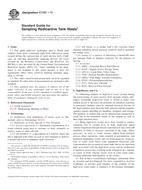Potřebujeme váš souhlas k využití jednotlivých dat, aby se vám mimo jiné mohly ukazovat informace týkající se vašich zájmů. Souhlas udělíte kliknutím na tlačítko „OK“.
ASTM C1751-11
Standard Guide for Sampling Radioactive Tank Waste
Automaticky přeložený název:
Standardní příručka pro vzorkování nakládání s radioaktivními odpady Tank
NORMA vydána dne 1.6.2011
Informace o normě:
Označení normy: ASTM C1751-11
Poznámka: NEPLATNÁ
Datum vydání normy: 1.6.2011
Kód zboží: NS-12364
Počet stran: 7
Přibližná hmotnost: 21 g (0.05 liber)
Země: Americká technická norma
Kategorie: Technické normy ASTM
Kategorie - podobné normy:
Anotace textu normy ASTM C1751-11 :
Keywords:
core sampling, high-level waste, radioactive waste, sampling tank waste, slurry sampling, ICS Number Code 13.030.30 (Special wastes)
Doplňující informace
| Significance and Use | ||||||||||||||||||||||||||||||||||||||||||||||||||||||||||||||||||||
|
Obtaining samples of high-level waste created during the reprocessing of spent nuclear fuels presents unique challenges. Generally, high-level waste is stored in tanks with limited access to decrease the potential for radiation exposure to personnel. Samples must be obtained remotely because of the high radiation dose from the bulk material and the samples; samples require shielding for handling, transport, and storage. The quantity of sample that can be obtained and transported is small due to the hazardous nature of the samples as well as their high radiation dose. Many high-level wastes have been treated to remove strontium (Sr) or cesium (Cs), or both, underwent liquid volume reductions through forced evaporation or have been pH modified, or both, to decrease corrosion of the tanks. These processes, as well as waste streams added from multiple process plant operations, often resulted in precipitation, and produced multiphase wastes that are heterogeneous. Evaporation of water from waste with significant dissolved salts concentrations has occurred in some tanks due to the high heat load associated with the high-level waste and by intentional evaporative processing, resulting in the formation of a saltcake or crusts, or both. Organic layers exist in some waste tanks, creating additional heterogeneity in the wastes. Due to these extraordinary challenges, substantial effort in research and development has been expended to develop techniques to provide grab samples of the contents of the high-level waste tanks. A summary of the primary techniques used to obtain samples from high-level waste tanks is provided in Table 1. These techniques will be summarized in this guideline with the assumption that the tank headspace is adequately ventilated during sampling. TABLE 1 High-Level Waste Tank Sampling Methods
|
||||||||||||||||||||||||||||||||||||||||||||||||||||||||||||||||||||
| 1. Scope | ||||||||||||||||||||||||||||||||||||||||||||||||||||||||||||||||||||
|
1.1 This guide addresses techniques used to obtain grab samples from tanks containing high-level radioactive waste created during the reprocessing of spent nuclear fuels. Guidance on selecting appropriate sampling devices for waste covered by the Resource Conservation and Recovery Act (RCRA) is also provided by the United States Environmental Protection Agency (EPA) (1). Vapor sampling of the head-space is not included in this guide because it does not significantly affect slurry retrieval, pipeline transport, plugging, or mixing. 1.2 The values stated in inch-pound units are to be regarded as standard. No other units of measurement are included in this standard. 1.3 This standard does not purport to address all of the safety concerns, if any, associated with its use. It is the responsibility of the user of this standard to establish appropriate safety and health practices and determine the applicability of regulatory limitations prior to use. |
||||||||||||||||||||||||||||||||||||||||||||||||||||||||||||||||||||
| 2. Referenced Documents | ||||||||||||||||||||||||||||||||||||||||||||||||||||||||||||||||||||
|
||||||||||||||||||||||||||||||||||||||||||||||||||||||||||||||||||||
Odebírejte informace o nově vydaných normách ZDARMA:
Chcete pravidelně odebírat informace o nově vycházejících normách z celého světa a to zcela zdarma?
Přihlašte se k odběru. Vše je velice jednoduché a absolutně ZDARMA.
Na výběr máte vydavatele z celého světa.




 Cookies
Cookies
